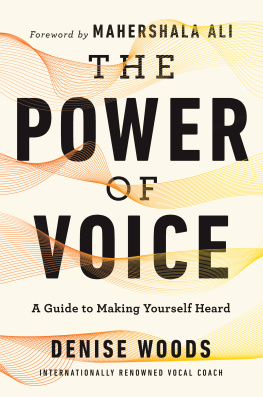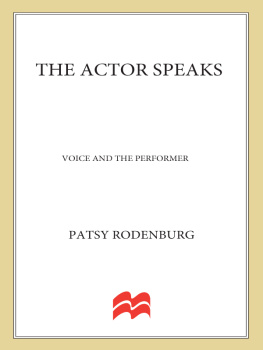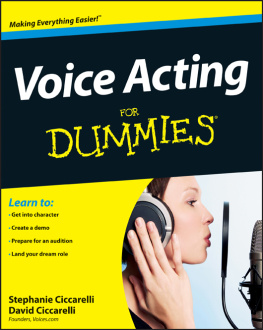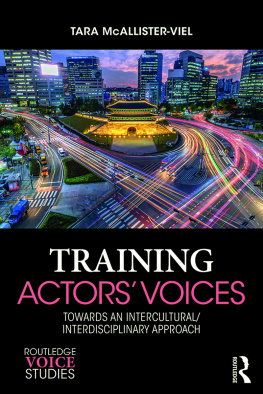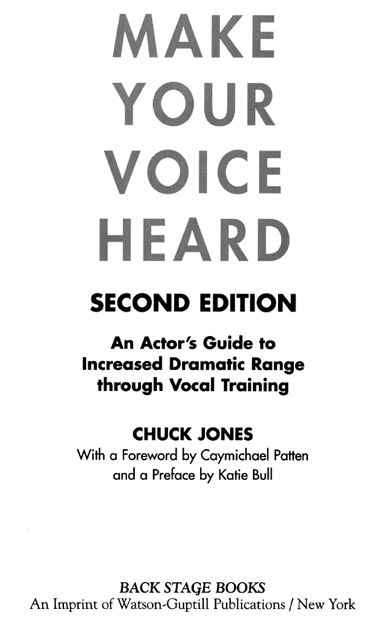I have had the great good fortune to work with some remarkable people, many of whom have made generous contributions to this book.
I want to thank David Wells, Katie Bull, Emily Caigan, Judylee Vivier, Francine Zerfas, Mark Glubke, Adina Porter, Paul Lukas, Dale Ramsey, Nels Hennum, Gloria Hale, Ziva Kwitney, David Farkas, Elizabeth Himelstein, Linda de Vries, Tanya Berezin, Edie Falco, Carla Gugino, Jessica Hecht, Thom Jones, Deborah Laufer, Joan Potter, Francie Swift, Lisa Story, and anyone I have failed to mention.
I also owe Joe Stockdale, Howard Stein, Caymichael Patten, David Garfield, Linda Swenson, Michael Howard, and Ryland Jordan a special thanks for many years of support.
I could not have done this book without the exceptional help and guidance of Alexis Greene, who edited this book. Her important input has been extraordinary, and I am so grateful to her.
A NOTE TO MY READERS
The exercises described in this book have been used successfully by thousands of actors. If any exercises cause discomfort, eliminate them from your practice. Please see your physician and get his or her approval on the exercises.
CHUCK JONES
CONTENTS
FOREWORD
BY CAYMICHAEL PATTEN
Director, the Caymichael Patten Studio
When Chuck told me he was rewriting his book and asked if I would take a look at the foreword again, I reread the previous one, wondering if there was anything to change. I found myself re-reading his entire book, settling back into his words the way you relax into a pool of warm water: supported, free, buoyed up. At the end, I thought the same things about his work and his teaching that I had always thought, but more so.
While I was figuring how to write that down, I talked to some of his colleagues and former students, asking what of his work remained with them after they had stopped studying with him. They mentioned many things, but as with my own experience, primarily they said that what they learned had touched every part of their core beliefs about actinghad become so thoroughly absorbed that it had shaped who they were as performers. This work will stay with you forever; even better, it will keep working on your behalf as long as you do the exercises. So dive in.
I first met Chuck Jones when I was a young director coaching an actress for an audition for the Actors Studio. Chuck was her partner. Both of them were more experienced than I, so I was nervous. But I blossomed while working with Chuck. He may not have known it, but he was teaching even then, simply by the way he put his whole concentration on someone: with open attention, without judgment, listening for the essentials. Guess what? My notes to these two actors improved, because I began to pick out the essentials of what I was trying to saybecause thats what Chuck was responding to.
Ive seen that kind of attention when he was talking to a new student, who complained, Ive never been able to breathe right and act at the same time. Chuck zeroed in on this fellow and said, What is breathing right? Theres no special voice-class breathing or proper acting breathing. One of the ways we know whats happening with people is how they take a breath.
I could see the actors face soften as it dawned on him that Chucks work wasnt going to be the typical voice-class hokum. Instead, the work emphasized connecting the actors voice to his or her emotional life. Thats what we all recognize as truthfulness.
So Ive sent Chuck many students over the years, saying to them, If you think this work has nothing to do with your acting, youre wrong. Do the exercises and your acting will get better. And it does. Actors come away from his work more in touch with themselves, more relaxed, more deeply connected emotionally, more responsive to their core, acting selves.
I hope Im communicating what a terrific teacher Chuck Jones is and what a boon his approach is to the actor. If you cant study with him directly, or if you have worked with him and need a reminder, this book is for you.
PREFACE
BY KATIE BULL
Chuck Jones invited me to share my personal vocal journey as a student and as a teacher. To be invited by ones mentor to talk about personal experience is an extraordinary honor.
I am grateful to Chuck for the work to which he introduced me over two decades ago. I was a scared, sixteen-year-old freshman when we first meta theater arts and acting major at the State University of New York at Purchase. I had come to acting training from an experimental dance and jazz singing background, and I kept wishing there could be a more physical approach to the process of acting. The voice work with Chuck was the bridgethe missing linkto the visceral realm of spontaneous, unpredictable acting where connecting to a released breath equals the present moment of expression. Indeed, as I became more vocally connected, many aspects of the acting craft started to work for me. My whole body became engaged in listening, observing, experiencing the other person and responding. A whole unpremeditated, interactive world opened up; intuition, and the joy of doing plays, returned.
Two decades after learning what I call the core exercises, they are still the same, and anatomy still dictates the sequence. Thats the beauty of this work: it is based upon the organic design of the human animal. The sequence leads you into encountering where you are vocally and emotionally trapped. Thats why, when I teach, I emphasize doing the full sequence and not skipping. However, I have made adaptations and integrated elements from my knowledge of the voice through jazz singing, postmodern dance improvisation, Iyengar Yoga, Contact Improvisation, and the Laban Effort/Shape system of movement. These are all compatible ways of finding alignment for deeper breathing and impulse release. Chuck always used to say, Make it your own.
I went on to study several other crafts of acting, always finding that an aligned, alert, energized, and breath-connected instrument was the way to remain truthful within the various craft structures presented. Whether you are an actor who initiates work on a script in a primal, intuitive way or one who chooses to analyze a script intellectually first, this work is essential. My advanced classes are now called Vocal Integration Forums. Voice work must integrate with your particular craft of acting; if it doesnt, something is not working. You can identify the obligations to the text, you can score the script, you can scan, grasp rhetoric, emphasize operative words. But in the final moment of truth, if you are not breathing and supporting the release of a full vocal impulse, the work is not alive. Its all in your head. And it just isnt interesting.
In this revised and updated book, Chuck has chosen to include some contributions from a new generation of vocal production coaches, all of whom trained with him. This work can be taught in a myriad of styles, with numerous emphases, and for a wide range of uses. For myself, the vocal honesty, range, and power I first heard in Chucks class over twenty years ago propelled me into a deeper dedication to the theater, and I have chosen to focus on training professional actors. If, to rephrase Shakespeare slightly, the play is the thing that catches the conscience of the king, well, thats what I want to support as a professional vocal-production coach. I want to support actors in plays that have at their essence vibrant truth, whatever the writing style, whatever the performing style. Truth is what this world needs now. Artists change lives and societies. In theater, stories wake us up to what we care about, or might not have realized we care about.




